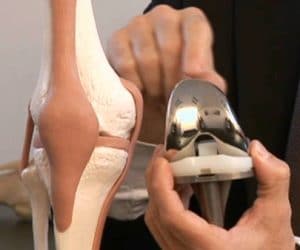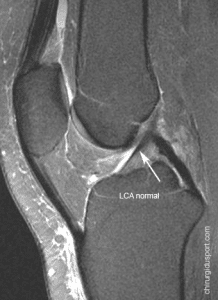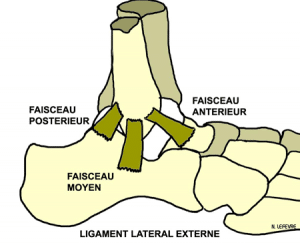Studies show that women are 5 times more sprains than men. One begins to understand why! Preventive strategies are now resulting in more efficient!
A sprain is a stretching see a ruptured ligament, the cord connecting two bones in joints. The most famous of them is probably the anterior cruciate ligament. It attempts to limit the movement of the knee. It may tear during rotation or flip-flops of this articulation when placed in the vicinity of the extension. His break often requires surgery and rehabilitation for several months. Even well made, that knee 10 times more likely to develop OA than its neighbor! Therefore, the anterior cruciate ligament is often taken as an example and is the subject of attention of scientists!
Too soft tissues.
Female ligaments stretch leave more easily, we speak of laxity. It is likely that evolution has selected this characteristic tissue to promote the opening of the pelvis during childbirth. SCOVILLE showed that individuals the hypermobile individuals were 3 times more sprain of the anterior cruciate ligament. It is unlikely that this very flexible ligament is more fragile … on the contrary, it leaves stretch longer before breaking. In contrast, the membrane surrounding the joint is so flexible that it too easily from the knee in extension and strong rocking! In this position the ligament is stretched, a simple rotation is enough to break it. Moreover, muscle envelopes are also too soft. The muscles are insufficiently tensioned well to control the joint posture.
Less strong and uncoordinated muscles.
To stabilize the joints, muscles must be strong, steadfast and vigilant. Female hormones are much less effective than male testosterone to give muscle power. One study showed that the articular wear depended more muscle volume than sex. Clearly, a well-muscled woman better control its joint movements and develops osteoarthritis least a puny human! It is also likely to make fewer sprain! Usually, women take delivery of the vicinity of the knee extension … in a risky position for the cruciate ligament. For lack of strength, joint lock braking replaces muscle. We need more bending to the hamstrings on the back of the thigh, managed to pull the tibia backward and relax the cross. Electrical recordings of muscle contractions show that women too are seeking their quadriceps and hamstrings in their insufficiently jump landing. The tibia is pulled forward, the cross is stretched … in pre-breaking position!
A specific anatomy
X legs, more typically female, prove dangerous to cross. Bone corridor in which it is situated is narrower. When rotations and flops, he comes faster twist on the banks of the canal. The women’s cross is also thinner. He broke for a voltage … at the corpses! The leggy mannequins without muscle bumping knees on the catwalks … are at high risk of breaking the cross! Finally, there is justice!
Still hormones!
You learned that female hormones distended ligaments and did not stimulate enough muscle development! Know that in addition, the menstrual cycle is involved in the breakdown of the cross. There are three more risk of a serious knee sprain in the first part of the cycle, between the first and the fourteenth day of the onset of menstruation and ovulation. This is a finding that it is not clear justification! Anyway, in addition to school holiday dates and promotions tour operators, this is an additional parameter to consider before choosing the dates of your next ski holiday! Studies on the preventive value of the pill are divergent. It is likely that newer low-dose are less effective in preventing the risk of rupture of the cruciate.
Awareness and technical alterations!
Several strategies must come together to reduce the risk of severe knee sprain. Henning suggested to basketball players of the first American division to decelerate over 3 steps instead of stopping abruptly. He asked them to turn on rounded trajectories replacing pivots. Injuries have decreased by 89%. One must be aware of the problem and understood the dangerous movements. Four thousand ski instructors who watched a video showing ten typical accidents decreased by 62% failure rate of their cross during the next season! So, remember the basics! Do not you receive strained knee, rocking to the other knee!
EXERGUE: RECEPTION BENDING and “DOUBLE SUPPORT” LIMIT THE RISK OF KNEE SPRAINS.
Coordination and strengthening!
At each jump, amortize and steady recovery support by bending the knee and left in the center! Fold also the upper body forward to stretch the hamstrings. On the ground, made the journey between studs and hoops. Strengthen your muscles. Even better ! Learn to stop or change direction by taking a “dual support”. Balanced simultaneously on the right foot and the left foot. Your joints are more stable; you are more apt to change your path if your opponent assenait you a new feint. Indoor use squats or the press, record 45 ° and machines hamstring. At home, perform squats on one leg, foot on a pillow or mattress. To work the hamstrings, lie down on the floor, bend your knees a little, put your heels on a chair or on a large ball and mount the basin. Whenever possible these exercises are performed successively with the other leg and then to reproduce more specifically the recovery support on one foot. Mattresses and balloon tips are particularly useful because too much weight in stable position freezes your coordination and impairs your ability to respond to the imbalance. Limit easing, women are already very lax! Avoid static stretching position to warm up, they decrease protective muscle elasticity and inhibit contraction reflexes controlling the joint position.
Doctor Nicolas LEFEVRE, Doctor Yoann BOHU, Doctor Serge HERMAN. – 23 octobre 2013.



